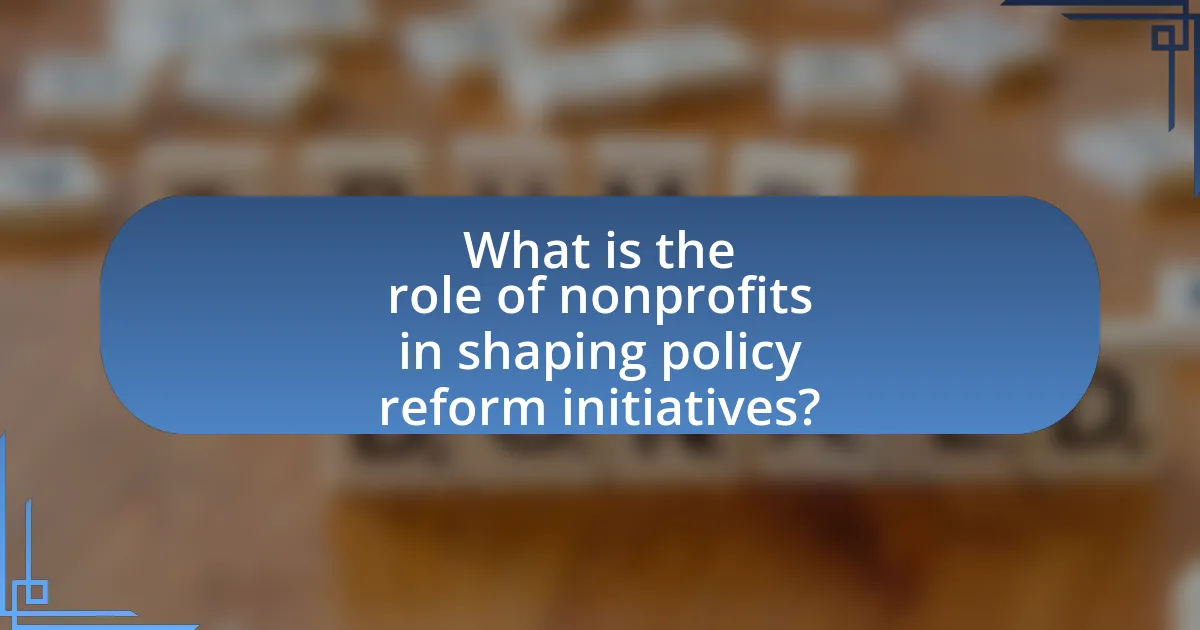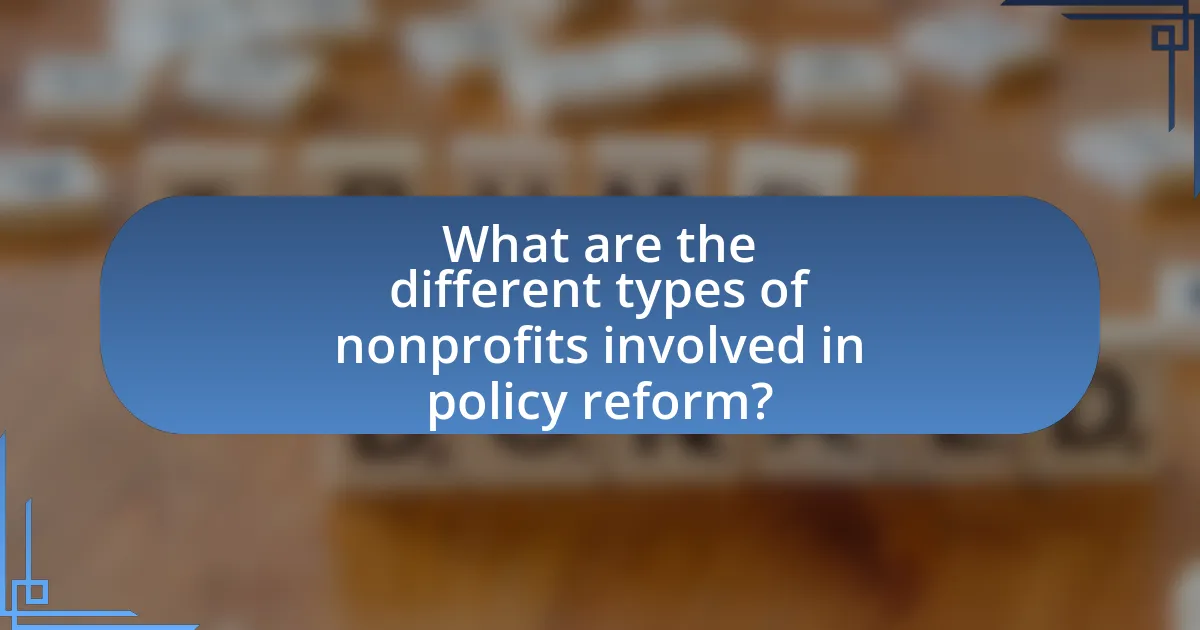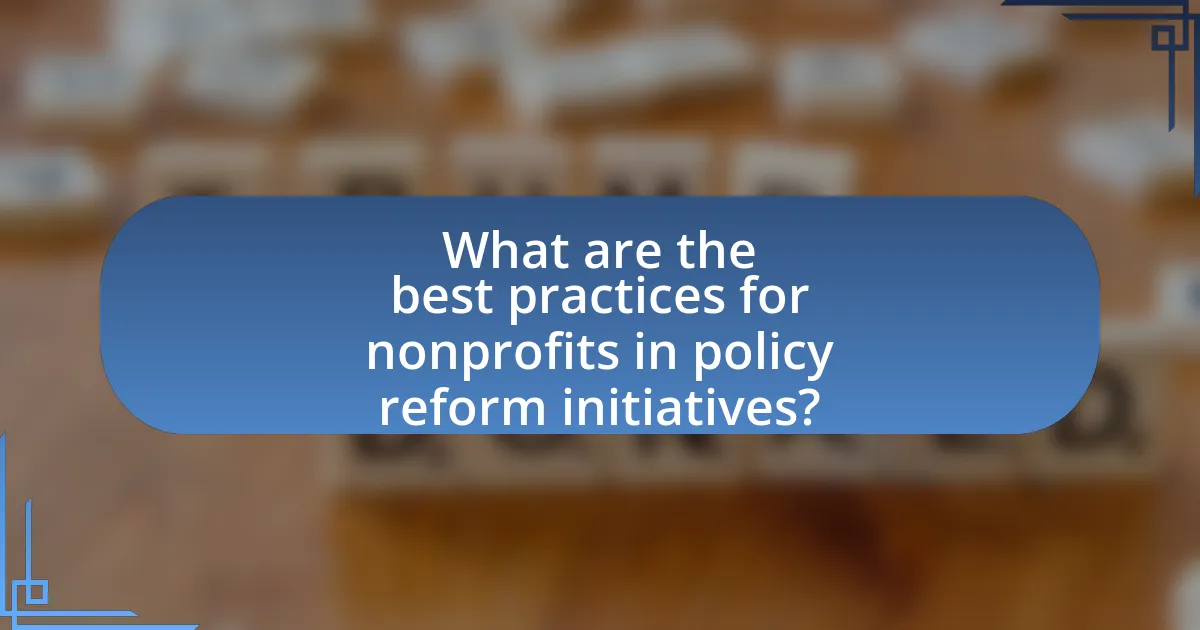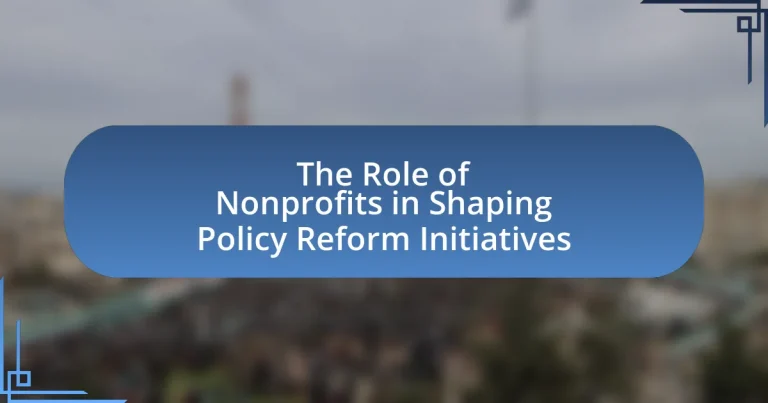Nonprofits play a vital role in shaping policy reform initiatives by advocating for social change, mobilizing community support, and providing expertise on various issues. They influence policy decisions through advocacy, lobbying, and public engagement, employing strategies such as grassroots mobilization and coalition building. The article explores how nonprofits collaborate with government entities, the unique perspectives they bring to policy discussions, and the challenges they face in the reform process. Additionally, it highlights best practices for effective advocacy, the importance of data in supporting policy initiatives, and the distinctions between different types of nonprofits involved in policy reform.

What is the role of nonprofits in shaping policy reform initiatives?
Nonprofits play a crucial role in shaping policy reform initiatives by advocating for social change, mobilizing community support, and providing expertise on specific issues. They influence policymakers through research, public awareness campaigns, and grassroots organizing, which can lead to legislative changes. For instance, organizations like the American Civil Liberties Union have successfully lobbied for reforms in criminal justice policies, demonstrating the effectiveness of nonprofit advocacy in driving significant policy shifts.
How do nonprofits influence policy decisions?
Nonprofits influence policy decisions primarily through advocacy, lobbying, and public engagement. They mobilize resources to raise awareness about specific issues, thereby shaping public opinion and encouraging policymakers to consider their perspectives. For instance, organizations like the American Civil Liberties Union (ACLU) have successfully influenced legislation by litigating cases that highlight civil rights issues, demonstrating the power of legal advocacy in shaping policy. Additionally, nonprofits often conduct research and disseminate findings that inform policymakers, as seen with the Pew Research Center, which provides data that influences public policy discussions. These actions collectively enable nonprofits to play a critical role in the policy-making process.
What strategies do nonprofits use to advocate for policy change?
Nonprofits utilize various strategies to advocate for policy change, including grassroots mobilization, coalition building, lobbying, and public awareness campaigns. Grassroots mobilization involves engaging community members to participate in advocacy efforts, which can amplify voices and demonstrate public support for specific policies. Coalition building allows nonprofits to unite with other organizations to strengthen their influence and share resources, making their advocacy efforts more effective. Lobbying involves direct interaction with policymakers to persuade them to support specific legislation or regulations, often backed by research and data to substantiate their positions. Public awareness campaigns aim to educate the general public and raise awareness about issues, thereby creating pressure on policymakers to act. These strategies are supported by evidence showing that coordinated advocacy efforts can lead to significant policy changes, as seen in successful campaigns for healthcare reform and environmental protections.
How do nonprofits collaborate with government entities in policy reform?
Nonprofits collaborate with government entities in policy reform through advocacy, research, and partnership initiatives. These organizations often engage in lobbying efforts to influence legislation, providing data and expertise that inform policy decisions. For instance, nonprofits like the American Civil Liberties Union (ACLU) have successfully worked with government bodies to shape laws regarding civil rights by presenting research and mobilizing public support. Additionally, collaborative efforts can include joint task forces or committees where nonprofits and government representatives discuss and develop policy proposals, ensuring that diverse perspectives are considered in the reform process. This collaborative approach enhances the effectiveness of policy initiatives by integrating community needs and expert insights.
Why are nonprofits essential in the policy reform process?
Nonprofits are essential in the policy reform process because they advocate for marginalized communities and influence public policy through research, education, and mobilization. By representing diverse perspectives, nonprofits provide critical insights that inform policymakers about the needs and challenges faced by various populations. For instance, organizations like the American Civil Liberties Union (ACLU) have successfully lobbied for reforms in criminal justice and civil rights, demonstrating the impact of nonprofit advocacy on legislative change. Their ability to mobilize grassroots support and engage in lobbying efforts amplifies the voices of those often overlooked in the political arena, making them vital players in shaping effective and equitable policies.
What unique perspectives do nonprofits bring to policy discussions?
Nonprofits bring community-focused perspectives to policy discussions, emphasizing the needs and voices of marginalized populations. Their grassroots connections enable them to identify specific issues that may be overlooked by traditional policymakers, such as social justice, environmental sustainability, and public health. For instance, a study by the National Council of Nonprofits highlights that nonprofits often serve as intermediaries between the government and the community, advocating for policies that reflect the lived experiences of those they serve. This unique position allows nonprofits to provide valuable insights and data that can inform more equitable and effective policy decisions.
How do nonprofits mobilize community support for policy initiatives?
Nonprofits mobilize community support for policy initiatives by engaging in grassroots organizing, advocacy campaigns, and coalition-building. These organizations often conduct outreach efforts to educate community members about specific issues, fostering awareness and encouraging participation. For instance, nonprofits may host town hall meetings, distribute informational materials, and utilize social media platforms to reach a broader audience. Research indicates that community engagement strategies, such as door-to-door canvassing and public forums, significantly increase public support for policy changes. A study by the National Council of Nonprofits highlights that nonprofits leveraging local networks can effectively amplify their message and mobilize constituents to advocate for policy reforms.
What challenges do nonprofits face in shaping policy reform?
Nonprofits face significant challenges in shaping policy reform, primarily due to limited resources, political opposition, and the complexity of the legislative process. Limited funding restricts their ability to conduct research, mobilize communities, and advocate effectively, as evidenced by a 2020 report from the National Council of Nonprofits, which highlighted that 70% of nonprofits operate with budgets under $500,000. Political opposition can arise from vested interests that may resist changes proposed by nonprofits, particularly in contentious areas like healthcare or environmental policy. Additionally, the legislative process is often intricate and slow, requiring nonprofits to navigate various bureaucratic hurdles and build coalitions, which can be time-consuming and resource-intensive. These factors collectively hinder the ability of nonprofits to influence policy effectively.
How do funding limitations impact nonprofit advocacy efforts?
Funding limitations significantly hinder nonprofit advocacy efforts by restricting their ability to mobilize resources, conduct research, and engage in outreach activities. Nonprofits often rely on grants and donations to support their initiatives; when funding is insufficient, they may have to scale back programs, limit staff, or reduce advocacy campaigns. For instance, a study by the National Council of Nonprofits found that 70% of nonprofits reported that funding constraints directly impacted their ability to advocate effectively for policy changes. This reduction in capacity can lead to diminished influence in policy discussions, ultimately affecting the nonprofit’s ability to drive meaningful reform.
What role does public perception play in nonprofit-led policy initiatives?
Public perception significantly influences nonprofit-led policy initiatives by shaping the priorities and strategies of these organizations. Nonprofits often rely on public support to advocate for policy changes, and favorable public perception can enhance their credibility and effectiveness. For instance, a study by the Stanford Social Innovation Review found that nonprofits with strong public backing are more successful in mobilizing resources and influencing policymakers. This demonstrates that public opinion not only affects the visibility of nonprofit initiatives but also impacts their ability to drive meaningful policy reform.
How do nonprofits measure their impact on policy reform?
Nonprofits measure their impact on policy reform through a combination of quantitative and qualitative metrics. They often track changes in legislation, policy adoption rates, and the extent of stakeholder engagement as direct indicators of their influence. For example, a study by the National Council of Nonprofits highlights that organizations frequently utilize surveys and interviews to assess shifts in public opinion and policy outcomes, providing concrete evidence of their effectiveness. Additionally, nonprofits may analyze data from government reports and legislative records to quantify their contributions to specific reforms, demonstrating their role in shaping policy initiatives.
What metrics are used to evaluate the success of nonprofit advocacy?
Metrics used to evaluate the success of nonprofit advocacy include policy changes, public awareness, coalition building, and funding increases. Policy changes are measured by the number and significance of legislative or regulatory outcomes influenced by advocacy efforts. Public awareness is assessed through surveys and media coverage that indicate shifts in public opinion or knowledge regarding specific issues. Coalition building is evaluated by the number and diversity of partnerships formed, which can enhance advocacy effectiveness. Funding increases are tracked through financial contributions and grants received as a direct result of advocacy campaigns, reflecting increased support for the nonprofit’s mission. These metrics provide a comprehensive framework for assessing the impact and effectiveness of nonprofit advocacy initiatives.
How can nonprofits improve their effectiveness in policy reform?
Nonprofits can improve their effectiveness in policy reform by enhancing their advocacy strategies and building coalitions with other organizations. Effective advocacy involves clear messaging, data-driven arguments, and engaging storytelling to influence policymakers. For instance, the Center for American Progress reported that nonprofits utilizing comprehensive data analytics in their campaigns saw a 30% increase in legislative engagement. Additionally, forming coalitions allows nonprofits to pool resources, share expertise, and amplify their voices, which can lead to more significant policy impact. Research from the National Council of Nonprofits indicates that collaborative efforts among nonprofits can result in more robust policy proposals and greater success in achieving legislative goals.

What are the different types of nonprofits involved in policy reform?
Different types of nonprofits involved in policy reform include advocacy organizations, think tanks, service organizations, and grassroots groups. Advocacy organizations focus on influencing public policy through lobbying and public campaigns, such as the American Civil Liberties Union, which works on civil rights issues. Think tanks, like the Brookings Institution, conduct research and provide policy recommendations to inform lawmakers. Service organizations, such as the United Way, may engage in policy reform to improve community services and address systemic issues. Grassroots groups mobilize community members to advocate for change, often focusing on local issues. Each type plays a distinct role in shaping policy through research, advocacy, and community engagement.
How do advocacy nonprofits differ from service nonprofits?
Advocacy nonprofits focus on influencing public policy and social change, while service nonprofits primarily provide direct assistance and support to individuals or communities. Advocacy organizations engage in activities such as lobbying, public education, and mobilizing citizens to address systemic issues, aiming to create long-term change in laws or regulations. In contrast, service nonprofits deliver programs and services that meet immediate needs, such as food distribution, healthcare, or education, without necessarily seeking to change the underlying policies that create those needs. This distinction is evident in the operational goals of each type; for example, organizations like the American Civil Liberties Union (ACLU) advocate for civil rights, whereas local food banks provide essential food supplies to those in need.
What are the primary goals of advocacy-focused nonprofits?
The primary goals of advocacy-focused nonprofits are to influence public policy, raise awareness about social issues, and mobilize community action. These organizations aim to create systemic change by advocating for specific legislative reforms, educating the public and policymakers about critical issues, and fostering grassroots movements. For example, organizations like the American Civil Liberties Union (ACLU) work to protect civil rights through litigation and lobbying efforts, demonstrating the effectiveness of advocacy in shaping policy.
How do service nonprofits contribute to policy reform indirectly?
Service nonprofits contribute to policy reform indirectly by providing essential services that highlight systemic issues and mobilize community engagement. Through their direct interactions with underserved populations, these organizations gather data and insights that reveal gaps in existing policies. For example, a nonprofit focused on housing may document the challenges faced by low-income families, which can inform policymakers about the need for affordable housing initiatives. Additionally, service nonprofits often engage in advocacy efforts, raising awareness and fostering public discourse around specific issues, thereby influencing the political landscape and encouraging policymakers to consider reforms. This dual role of service provision and advocacy creates a feedback loop that can lead to meaningful policy changes over time.
What role do grassroots organizations play in policy reform?
Grassroots organizations play a crucial role in policy reform by mobilizing community members to advocate for change and influence decision-makers. These organizations often represent marginalized voices, ensuring that the needs and concerns of local populations are addressed in the policy-making process. For example, grassroots movements have successfully led initiatives such as the Civil Rights Movement in the 1960s, which resulted in significant legislative changes like the Voting Rights Act of 1965. Their ability to organize protests, raise awareness, and build coalitions amplifies their impact, making them essential players in shaping effective and equitable policies.
How do grassroots movements influence larger nonprofit agendas?
Grassroots movements significantly influence larger nonprofit agendas by mobilizing community support and raising awareness around specific issues. These movements often highlight local concerns that may be overlooked by larger organizations, prompting nonprofits to adapt their strategies and priorities to align with grassroots demands. For instance, the Black Lives Matter movement has compelled many nonprofits to incorporate racial justice into their missions, reflecting the urgent calls for systemic change from grassroots activists. This alignment not only enhances the relevance of nonprofit agendas but also strengthens their advocacy efforts by leveraging the passion and engagement of grassroots supporters.
What strategies do grassroots organizations employ to effect change?
Grassroots organizations employ strategies such as community mobilization, advocacy, coalition building, and public awareness campaigns to effect change. Community mobilization involves organizing local residents to participate in initiatives that address their specific needs, fostering a sense of ownership and empowerment. Advocacy efforts focus on influencing policymakers through lobbying, providing research, and presenting testimonies that highlight community issues. Coalition building brings together diverse groups to amplify their voices and resources, enhancing their collective impact. Public awareness campaigns utilize media and social platforms to educate the broader public about issues, thereby generating support and pressure for change. These strategies have been effective in various movements, such as the Civil Rights Movement, where grassroots efforts led to significant legislative changes.
How do national vs. local nonprofits approach policy reform?
National nonprofits typically approach policy reform through broad advocacy efforts and large-scale campaigns aimed at influencing federal or state legislation, while local nonprofits focus on grassroots initiatives that address community-specific issues and engage directly with local government. National organizations often leverage extensive resources, networks, and data to shape policy at a macro level, as seen in the work of organizations like the American Civil Liberties Union, which campaigns for nationwide civil rights reforms. In contrast, local nonprofits, such as neighborhood associations, prioritize direct community engagement and tailor their strategies to reflect the unique needs of their constituents, often resulting in localized policy changes that can be more immediately impactful. This distinction highlights the varying scales and methods of influence that national and local nonprofits employ in the policy reform landscape.
What are the advantages of local nonprofits in influencing policy?
Local nonprofits have significant advantages in influencing policy due to their deep community connections and specialized knowledge of local issues. These organizations often possess firsthand insights into the needs and challenges faced by their communities, allowing them to advocate effectively for policies that address specific local concerns. For example, a study by the National Council of Nonprofits highlights that local nonprofits can mobilize community members, fostering grassroots support that is crucial for policy change. Additionally, their established relationships with local government officials enhance their credibility and access, enabling them to participate in policy discussions and decision-making processes more effectively than larger, national organizations.
How do national nonprofits leverage their resources for local impact?
National nonprofits leverage their resources for local impact by providing funding, expertise, and advocacy support tailored to community needs. They often allocate grants to local organizations, enabling them to implement programs that address specific issues such as education, health, and poverty alleviation. For instance, the American Red Cross allocates resources for disaster relief efforts in local communities, ensuring that immediate needs are met effectively. Additionally, national nonprofits utilize data and research to inform local initiatives, enhancing their effectiveness. By collaborating with local stakeholders, they ensure that their strategies align with community priorities, thereby maximizing their impact.

What are the best practices for nonprofits in policy reform initiatives?
The best practices for nonprofits in policy reform initiatives include building coalitions, engaging stakeholders, and utilizing data-driven advocacy. Nonprofits should form alliances with other organizations to amplify their influence and share resources, as demonstrated by the successful coalition-building efforts seen in campaigns like the Affordable Care Act. Engaging stakeholders, including community members and policymakers, ensures that diverse perspectives are considered, which enhances the legitimacy of the reform efforts. Additionally, employing data-driven advocacy allows nonprofits to present compelling evidence to support their policy positions, as seen in studies that show how data can effectively sway legislative decisions. These practices collectively enhance the effectiveness and impact of nonprofit-led policy reform initiatives.
How can nonprofits effectively engage stakeholders in policy advocacy?
Nonprofits can effectively engage stakeholders in policy advocacy by building strong relationships, utilizing data-driven strategies, and fostering inclusive dialogue. Establishing trust through consistent communication and collaboration with stakeholders enhances engagement. For instance, nonprofits can leverage surveys and focus groups to gather insights, ensuring that stakeholder perspectives are integrated into advocacy efforts. Research indicates that organizations employing evidence-based approaches, such as the use of policy briefs and impact assessments, are more successful in influencing policy outcomes. A study by the National Council of Nonprofits highlights that nonprofits that actively involve stakeholders in the advocacy process see increased support and more effective policy changes.
What communication strategies enhance stakeholder engagement?
Effective communication strategies that enhance stakeholder engagement include transparent information sharing, active listening, and tailored messaging. Transparent information sharing fosters trust and ensures stakeholders are well-informed about initiatives and decisions. Active listening allows organizations to understand stakeholder concerns and feedback, which can be integrated into decision-making processes. Tailored messaging ensures that communication resonates with diverse stakeholder groups, addressing their specific interests and needs. Research indicates that organizations employing these strategies experience higher levels of stakeholder satisfaction and involvement, ultimately leading to more successful policy reform initiatives.
How can nonprofits build coalitions for stronger advocacy?
Nonprofits can build coalitions for stronger advocacy by identifying common goals and aligning their missions with like-minded organizations. This collaborative approach enhances resource sharing, amplifies voices, and increases influence on policy issues. For instance, the National Council of Nonprofits highlights that coalitions can leverage collective expertise and networks, leading to more effective advocacy campaigns. By pooling resources, nonprofits can also conduct joint research, share best practices, and coordinate outreach efforts, which ultimately strengthens their impact on policy reform initiatives.
What role does data play in nonprofit policy reform efforts?
Data plays a critical role in nonprofit policy reform efforts by providing evidence-based insights that inform decision-making and advocacy strategies. Nonprofits utilize data to identify social issues, measure the impact of existing policies, and demonstrate the need for reform. For instance, a study by the Urban Institute found that data-driven advocacy can lead to more effective policy changes, as organizations that leverage quantitative evidence are more likely to influence policymakers. Additionally, data helps nonprofits track progress and outcomes, ensuring accountability and transparency in their initiatives.
How can nonprofits utilize research to support their advocacy?
Nonprofits can utilize research to support their advocacy by leveraging data and evidence to inform policy decisions and influence public opinion. By conducting or commissioning studies, nonprofits can gather quantitative and qualitative data that highlights the issues they aim to address, demonstrating the need for policy reform. For instance, a report by the Urban Institute found that data-driven advocacy can lead to more effective policy outcomes, as it provides lawmakers with concrete evidence of the impact of proposed changes. This research can also help nonprofits identify key stakeholders, tailor their messaging, and mobilize supporters around specific issues, ultimately enhancing their ability to effect change in policy reform initiatives.
What types of data are most persuasive in policy discussions?
Quantitative data, such as statistics and empirical research findings, are the most persuasive types of data in policy discussions. This type of data provides measurable evidence that can support claims and influence decision-making. For instance, a study published in the Journal of Policy Analysis and Management found that policies backed by robust statistical evidence were more likely to be adopted by legislators. Additionally, qualitative data, including case studies and testimonials, can also be persuasive by illustrating the real-world impact of policies, as seen in reports from organizations like the Urban Institute, which highlight personal stories alongside data to strengthen their policy recommendations.
What are some common pitfalls for nonprofits in policy reform?
Common pitfalls for nonprofits in policy reform include lack of clear objectives, insufficient stakeholder engagement, and inadequate resources. Nonprofits often enter policy reform without well-defined goals, which can lead to ineffective advocacy efforts. Additionally, failing to engage key stakeholders, such as community members and policymakers, can result in a lack of support and missed opportunities for collaboration. Furthermore, many nonprofits underestimate the financial and human resources required for successful policy reform, which can hinder their ability to implement and sustain initiatives. These pitfalls are documented in various studies, highlighting the importance of strategic planning and resource allocation in effective policy advocacy.
How can nonprofits avoid mission drift during advocacy efforts?
Nonprofits can avoid mission drift during advocacy efforts by establishing clear, measurable objectives that align with their core mission. By defining specific goals that directly relate to their mission, organizations can maintain focus and ensure that their advocacy activities support their primary purpose. Research indicates that nonprofits with well-defined missions are more effective in their advocacy, as they can evaluate their efforts against these established objectives, thereby minimizing the risk of straying from their foundational goals.
What strategies can nonprofits use to maintain credibility in policy discussions?
Nonprofits can maintain credibility in policy discussions by ensuring transparency, engaging in evidence-based advocacy, and building coalitions with other stakeholders. Transparency involves openly sharing information about funding sources, decision-making processes, and organizational goals, which fosters trust among policymakers and the public. Evidence-based advocacy requires nonprofits to utilize data and research to support their positions, demonstrating that their recommendations are grounded in factual information. Additionally, forming coalitions with other organizations can amplify their voice and lend credibility through collective expertise and shared resources. For instance, a study by the National Council of Nonprofits highlights that organizations that collaborate with diverse stakeholders are perceived as more credible by policymakers.
What practical steps can nonprofits take to enhance their policy reform initiatives?
Nonprofits can enhance their policy reform initiatives by building strategic coalitions with other organizations and stakeholders. Collaborating with diverse groups amplifies their voice and increases the likelihood of influencing policy changes. For instance, the National Council of Nonprofits emphasizes that partnerships can leverage resources and expertise, leading to more effective advocacy efforts. Additionally, nonprofits should engage in data-driven advocacy by collecting and analyzing relevant data to support their policy positions. Research from the Urban Institute shows that evidence-based approaches significantly improve the credibility of advocacy efforts. Finally, nonprofits must invest in grassroots mobilization to empower community members to participate in advocacy, as demonstrated by the success of organizations like the Sierra Club, which mobilized thousands for environmental policy reforms.


